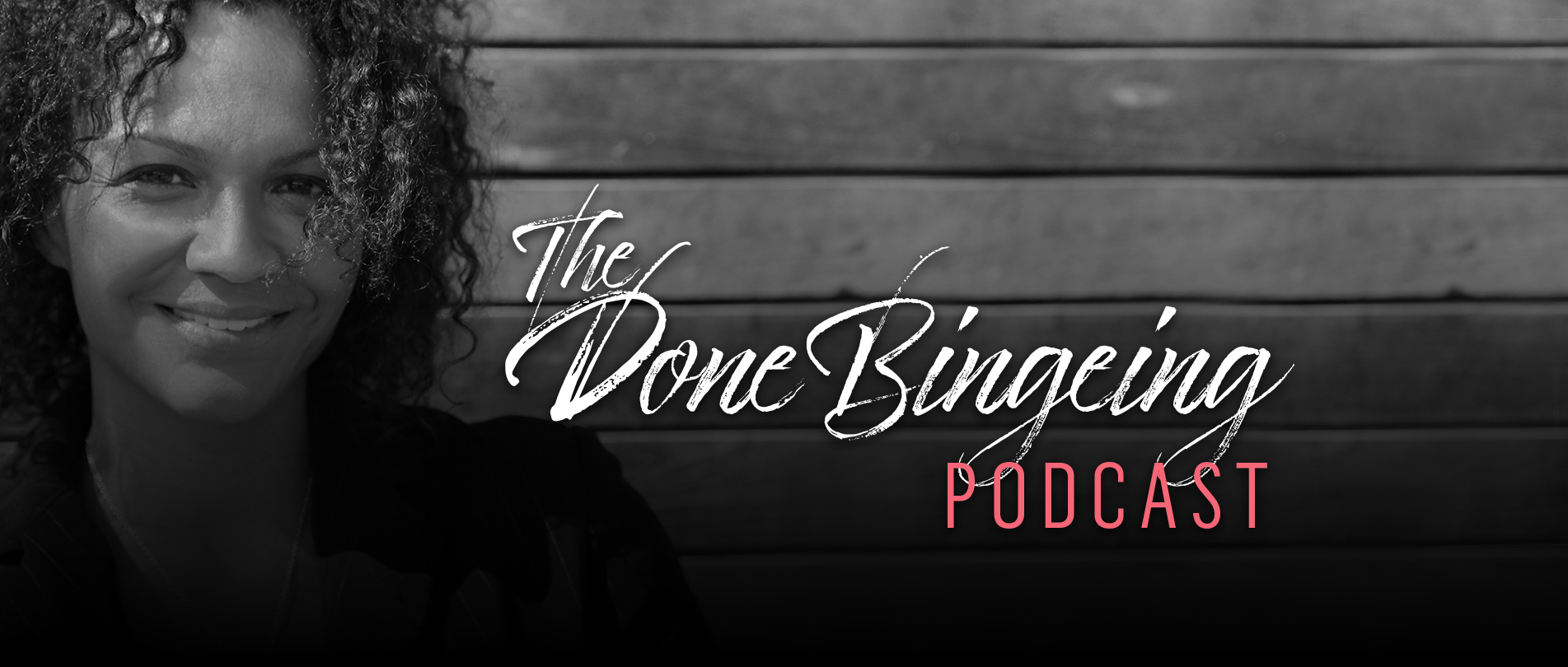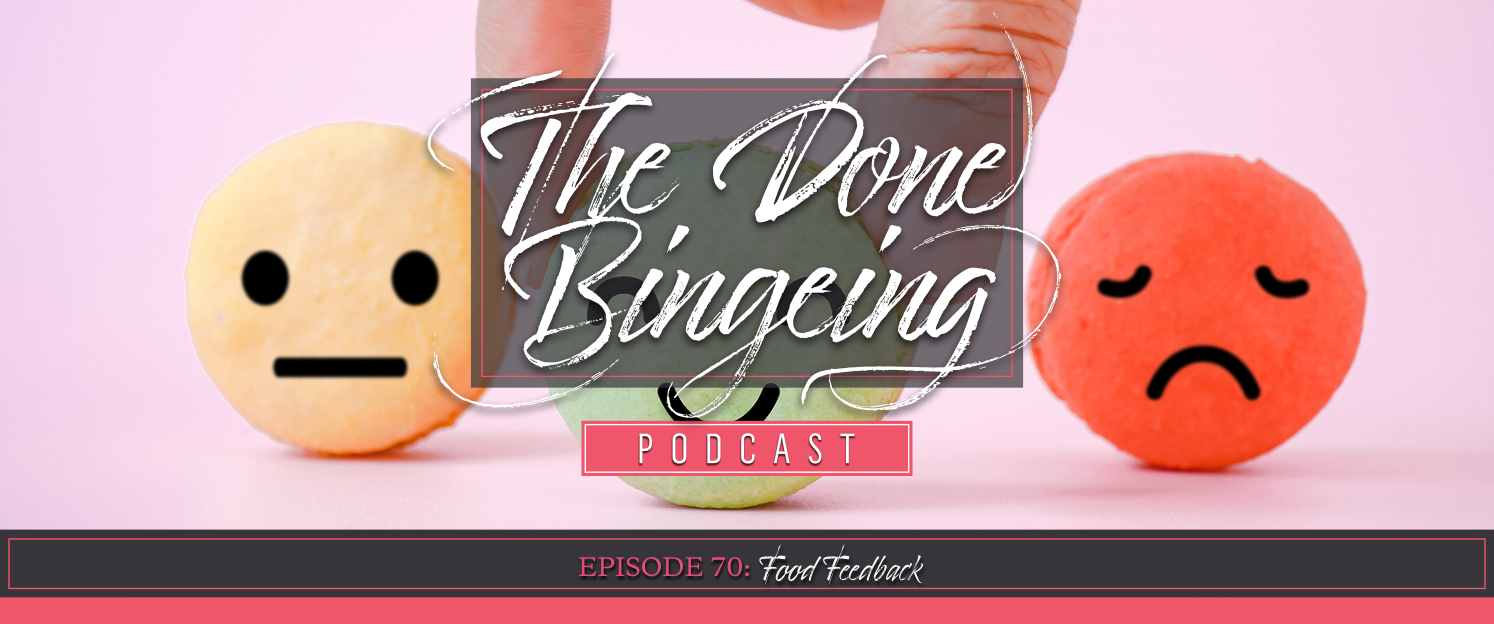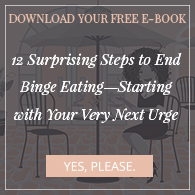
EP #70 Food Feedback

Sometimes it starts like this: We have food that’s concentrated in some way—maybe it’s extra savory, extra crunchy, extra sweet. And we have an amount in excess of what we need. Then we get more from the food beyond an ordinarily enjoyable way to nourish and sustain our bodies—we get an amplification of pleasure and fullness, a spike in energy, and a numbing of any pain that might be hanging around.
So far, so good, perhaps. But what next? When the eating stops and the effect of the food wears off, the amplified pleasure not only goes away, but we may feel a sense of withdrawal from it. The energy spike now becomes an energy drop. And the pain comes back.
Remembering that food gave us the heightened pleasure, increased energy, and escape from pain in the first place, we may go back for more. And now? Houston, we have a problem—a positive feedback loop in which the solution deepens the struggle.
Listen to episode 70 of The Done Bingeing Podcast where I explore three positive feedback loops central to the experience of binge eaters. Get full show notes and more information here: https://www.holdingthespace.co/70.
Want to call Mission Control? Go to https://www.holdingthespace.as.me/free30 and radio in for a free, 30-minute consultation.
Episode: Play in new window
Subscribe: Apple Podcasts| Stitcher| Google Podcasts | Spotify | iHeartRadio | Amazon Music | Deezer | RSS
- Peterson, J. B. (2018). 12 Rules for Life: An Antidote to Chaos. Toronto: Random House of Canada.
- Avildsen, J. G. (1976). Rocky. United Artists.
What does a sweat-soaked dude have to do with you and binge eating? Keep listening!
Welcome to The Done Bingeing Podcast. This is the place to hear about how you can pair the emerging brain science about why you binge with powerful life coaching to help you stop. If you want to explore an evidence-based, non-clinical approach to end binge eating, you’re in the right place.
It’s time to free yourself. You have more power than you know. To find out more, go to www.holdingthespace.co and click Programs.
And now, your host, Internal-Family-Systems-Level-3-Trained and Master-Coach-Certified Martha Ayim.
Hey friends, how are you? Happy New Year. If you are on my email list, you may have seen my post that went out on January 1st that quoted Rumi. Rumi once wrote, “Out beyond ideas of wrongdoing and rightdoing, there is a field, I’ll meet you there.” I quoted that in my Happy New Year’s post to my list and on my social media accounts, Facebook and Instagram. You can find me there @donebinging on Facebook and Instagram. And if you want to be on my list, you can shoot me an email at support@holdingthespace.co, not com, dot co.
The reason I sent that specific wish out to all of my followers is, That quote really signifies what we do here. We go beyond good and bad. We go beyond right and wrong. We go beyond black and white because between right and wrong, good and bad, good food, bad food, good days, bad days, food that’s right for us, food that’s wrong for us. Between all of the black and all of the white, there are so many shades of gray. Now, notice I didn’t say 50 shades of gray. I just said so many shades of gray. So if your brain is going there, that’s on you!
There are so many shades of gray, and one of the things you may have noticed about my post images is that most of them are in black and white. And the reason I love black and white photographs is because I think there’s so much intelligence even without color, and sometimes for me, the color obscures the beauty and the clarity that’s there.
I used to think that color brought more clarity to photographs and, in a way, it really does doesn’t it? And in some ways I found it personally distracting from all the information that was already there in the beauty of black and white. And that’s what we do on this podcast. You’ll notice in no episode that I have ever recorded, did I ever tell you about a diet, did I ever tell you about “right” foods, did I ever tell you about “wrong” foods. Because you can get that on every other podcast out there. On this podcast, we look at the intelligence, the insight, and the meaning, and the real healing that can be found in between.
You’ve been on that road, the diet-binge cycle many times. If you’re listening to this podcast, I would bet on that. So you already know how it goes with right and wrong, good and bad, black and white. And this podcast is about offering you all that’s left when we only look at two poles, because between the two poles there is an infinite amount of space, and that’s where we are on this podcast and in our work together. Happy New Year, my friend.
In this episode, I want to talk about food feedback. This episode has been inspired by Jordan B Peterson’s book 12 Rules for Life: An Antidote to Chaos. I want to talk about positive feedback loops and the three things that they require. They require an input detector, an amplifier, and an output source.
I want to talk about positive feedback loops in regard to three things that are common, if not central, experiences for binge eaters. I want to start with food. It can begin by having a meal where maybe we have a little more than we need. Maybe we have a lot more than we need, and maybe we enjoy it just a little bit more than the average person would enjoy an average meal.
And what happens is that amounts to a boost in energy that goes beyond what a rounded, nourishing meal would give us. Rounded, nourishing meals fuel us and sustain us meal-to-meal and give us a pretty consistent amount of energy, right? A pretty consistent, predictable level of energy throughout our days. But when we have more and when we focus on pleasure and when we eat foods that concentrate pleasure, that energy becomes a spike. More than just a leveling amount of energy throughout our day, it becomes a spike in energy.
We also have a spike in pleasure, and we also have a reduction in emotional pain, and that happens for a couple of reasons. One reason is because when we’re so focused on the pleasure we can get from the food, we have a different focus. So we’re focused less on something else that feels like a problem in our lives, and we have a focus switch to something that gives us more pleasure in our lives. That’s one reason.
Another reason is because when we are so focused on food and what it gives us and the taste and all of that, we can be so mesmerized by it that it becomes so—what’s the word?—it takes over our focus and numbs us out to the rest of the world, to the rest of our experience. And in that way, pain can be decreased, emotional pain, because we numb it out by focusing on something else.
The other thing is when we have gone through the energy spike and the pleasure spike, the energy then dips to a point where it often becomes an energy crash. And in that place, in that crash, where we feel dozy, sleepy—sometimes I’ve had some clients who literally fall asleep and they’re out for hours—there’s a numbing of, if not a complete escape from, the pain.
The other thing that happens after we get that amplification of the food, the pleasure, the energy, the decrease in pain is the pleasure, ultimately will decrease. The pain will come back again, and the crash I already mentioned will happen after the energy spike. That becomes a withdrawal from food in a way. And another thing that can happen is there can be a swingback effect that comes from feeling embarrassed about the way we ate. Getting so much pleasure from food, having more than we think a normal amount of food would be eaten by a “normal person” in a similar amount of time, in a similar situation. And so we might feel embarrassed.
We might feel shame and humiliation in front of others. Next to death, humiliation is one of our top two fears, so there can be this additional, inflamed response that adds pain to the pain that’s already there when the effect of the food goes away and the pain resurfaces.
And what’s the answer? Well, if when the food wore off, the pain increased, the pleasure decreased, and the energy dipped, what’s the response? The response often is food. And sometimes for binge eaters, what happens is this gets more and more and more pronounced, this loop, because maybe we want a little more food. Maybe we learned that, hey, the food actually does give us pleasure. It does numb out the pain. So maybe we have more of it. Maybe we have more concentrated forms of it. Sometimes what we notice is, if we get sated with a certain kind of food, like sweet food, we might swing to salty food and back and forth, right?
Sometimes the food isn’t even like chips and cakes and icings and all of that. It can be a salad that we just have more and more and more and more of. And I don’t mean like lettuce with vinegar splashed on it. I mean the kind of salad that people love and what that food could be, could be salad, it could be pasta, it could be meat, it could be chips, salty, crunchy, it could be a sweet, smooth texture. What that pleasure is for, for a person, differs from one person to another. And the feedback loop comes when food is the treatment for the struggle, but food was also the cause of the struggle. So now we have a loop, right?
So when we turn to food in the first place it is something that, for more than what it’s meant to give us, which is, something to enjoy as we fuel our body for consistent energy for our day. When we get more and more from that, and then after the effect of the food wears off, we feel depleted in some way, the way to treat that is often believed to be more food.
Now we have a feedback loop, a positive feedback loop where the treatment deepens the struggle. So now in this way, the cycle of bingeing and going back to food again and again, and maybe more and more, more often, more intensely, to more concentrated food—it makes sense when you think of it in terms of a loop.
Here’s another loop I want to look at: the urge before we binge. It was Dr. Gabor mate that first explained this to me. I didn’t realize that before I binged, I felt something. He was the one that pointed out that I felt something and if I waited long enough between when I wanted to binge and when I binged, I would discover what that thing was.
So I started to learn to practice. Pausing longer and longer so that I could feel what this urge was—and what it was, was desire. It could start out physiological. I might see something, I might smell something. I might have a taste of something. I might see a commercial. I might walk by a bakery, somebody in the office might have something for lunch. Do you know what I mean? It would be something that could start off like that, and then it would get amplified, the desire would get amplified maybe by social expectation or by social pressure.
Well, it was lunchtime at the office after all. Someone had brought in home-baked cookies because their child was raising money for something that they really, really needed to do, to experience in their life. And so there was a kind of pressure to partake, an expectation to partake. Or to have lunch together because it was a beautiful way to bond and it didn’t have to be a negative form of badgering or bullying. It could be like a positive social expectation, like “I want be with my colleagues whom I really love. What we’re doing right now is eating and I want to be a part of that. So that can amplify the desire.
It can also be amplified by my thinking about it. “I’m not going to have a chance again until I get home” or “I really need this food” or “When am I going to get homemade cookies again?” Maybe: “I need it now,” “I won’t be able to have it again,” “I don’t cook that stuff at home,” “I can’t waste it. I took one, I took a bite. Maybe it’s not really for me, but I can’t waste it.”
Whatever thoughts we have and our thoughts can be very unique to us. I have to say that one of the privileges of being a coach is that you have the profound honor of people sharing their stories with you. And what I’ve learned from being a coach for this long is, although our thoughts are unique to us because we’re unique individuals, there is so much overlap. And although the wording of the thoughts may change, the ultimate message of the thoughts, they’re pretty similar.
So when I take in that amplification, the social pressure/expectation, my own pressure/expectation, my thoughts that amplify what was just the sight of a cookie or the smell of bread, now I have more desire. So now I have more desire and then I amplify that again with more pressure, more thinking, that augments that even more. And now I start out with desire. I end up with more desire. And round and round I go.
Here’s another loop I want to talk about. Emotional pain. So let me go back to the urge again. So when we have that urge, which is basically a desire for food, and when we amplify it with social pressure thinking, et cetera, what we end up with is a more urgent desire. So we have more desire, we start out with desire, and now we have more of it.
When we move on to pain, which is the third feedback loop I want to talk about, we have emotional pain and we amplify that by telling ourselves, “This is really scary. This is really too much. I can’t bear this. This is really bad. This shouldn’t be happening. I really should be happy. If I was normal, I’d be happier. If it was normal, I wouldn’t be upset by this. Everybody else looks like they’re having a good time. I think I’m the only one who’s struggling with this” and all of that can amplify this pain.
When we think thoughts like that, usually there’s not only the emotional pain that was there in the first place. Now we top it with fear, sometimes panic, sometimes terror, resistance and physiologically we can tighten and shrink away from the pain, which is a physiological way of pushing it away. Our thoughts are pushing it away. Our bodies are pushing it away, but the pain is still there. And when we add pain to the pain that’s already there, now we have even more pain.
So here’s what happens. We start with some food, it’s amplified, we end up coming back for more food. We start with some desire, we amplify it and end up with more desire. We start with emotional pain, we amplify it, and we end up with more pain.
Food begets more food. Desire begets more desire. Pain begets more pain. And when you add food as a way to treat the urge and to treat the emotional pain, not only is it a way to treat the withdrawal from the food, the decrease in energy, the decrease in pleasure, and the resurgence of the pain, it’s also a phenomenal way to have a short-term treatment for the urgent desire because when you have food, it satisfies the urgent desire in the short term.
So now you have proof that something works and back you go again. When we have desire, let’s go for the food, because the food will decrease the pain of the desire because the urge is uncomfortable. The urges often feel like something we can’t bear. So many binge eaters will describe it to me as “I had to have it. The urge was unbearable. I just couldn’t take it anymore.”
So it makes sense why turning to food is a way to treat the urge to binge, makes sense as a strategy. It makes sense that turning to food as a way to deal with emotional pain, it makes sense as a short-term strategy.
So now food is a treatment plan for both food withdrawal, for the urge to binge, and for emotional pain.
You add to that, that we’re running away from the experience of the urge, which is a kind of pain, it’s a discomfort. We’re running away from the emotional pain. So now we have proof that there’s something about the urge, there’s something about the emotional pain that is to be feared, that is dangerous. Why? Because we’re running away and, by definition, we run away from things that are to be feared and that are dangerous. And the more we run away, the more we reinforce the belief that that pain, that urge, can’t be born, can’t be held. We can’t be with it. We can’t allow it. We can’t feel it.
So I wonder what if? What if we don’t have to run? What if it’s not that dangerous? What if it’s not that fearsome? Or what if it is that fearsome, and we can face it like Rocky did in the ring. When I was a teen, I was mesmerized by the Rocky movies, especially the first and second ones. In Rocky I, it didn’t matter that he lost because winning was being in the ring.
Even if right now you do run to food, because it’s a way to run away from pain. To treat the pain and make it go away. To run away from the urge to treat that urge and make it go away with the food, to run away from food withdrawal and treat food withdrawal with food to make that withdrawal go away. Even if you’re doing that right now, even if you’re running away, learning to even approach the stadium, to stay in the stadium, to approach the ring, to touch the ropes, and maybe even put a foot in to touch the floor, to move into the space. Any manner of that, any part of that is something, and that’s something is a firm step toward one day being in the ring.
Being in the ring, it’s not so much to fight the way Rocky did, but it’s to face. And that’s so much about what that movie was about was to face the pain, was to face defeat, was to face being knocked down and to get back up again. That willing to face something is something, and that’s something—like we learned in Rocky two three and beyond—becomes everything.
It becomes the ability to win. It becomes the ability to stay and survive pain, to be with pain and learn that it can be tolerated, it can be born, it can be more than tolerated and born, it can be felt and held.
And so I want to leave you with that, even if you’re running now, staying in the stadium, approaching the ring, touching the ropes, sweeping the floor, even with a finger is something, and that something becomes everything.
That’s it for episode 70. Thank you for listening. Remember, I’m here for you if you want some help staying in the stadium, approaching the ring, touching the ropes, and even stepping in. You have me and I’ve got your back. Book me for a free 30-minute consultation by going to https://www.holdingthespace.as.me/free30 and get on my calendar today.
Thanks for listening to The Done Bingeing Podcast.
Martha has the highest-level training in both the evidence-based Internal Family Systems approach and in life coaching, and she’s available to help you stop bingeing. You can learn more about her programs by going to www.holdingthespace.co and clicking Programs.
Stay tuned for the next episode on freeing yourself from binge eating and creating the life you want.
- Never miss an episode by subscribing via Apple Podcasts, Stitcher, Google Podcasts, Spotify, iHeartRadio, Amazon Music, Deezer or RSS.
- Leave a rating and review in Apple Podcast.
- Have a question or topic you’d like to see covered on the podcast? Send it on over to me here.
- If you found this episode valuable, it would mean so much to me if you would please share it with your friends
If you have any comments about this episode, drop me a line!
Click this link to send me an email.
Thank you so much for sharing your dreams with me.
Sending much love back to you!






















0 Comments